As an Amazon Associate I earn from qualifying purchases.
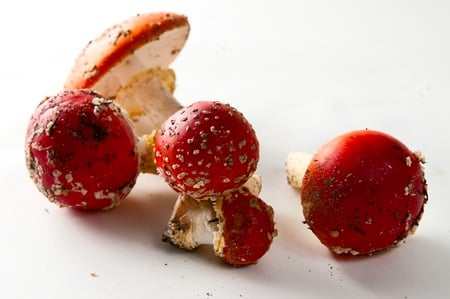
Editor’s Note: I have said this a lot in the comments before, in person and in the body of this post. Let me say it one more time, right up here in the beginning: Unless you are an expert mushroom hunter and you can 100 percent identify this mushroom, DON’T EAT IT. I wrote this post for other experts, not for just anyone to think they’ve found A. muscaria. This is serious stuff, folks. Mistake this mushroom for another amanita and you can die. Seriously. ~Hank
No mushroom presents more of an enigma than the fly agaric, Amanita muscaria. It is the most recognizable mushroom on the planet, and is widely known as the hallucinatory ‘shroom responsible for Alice’s trip into Wonderland and quite possibly our beloved images of a red-suited Santa Claus and his flying reindeer.
I am not into hallucinations. Or stomach cramping, for that matter. So for years I let this beautiful mushroom pass on my mushroom hunts. Until last weekend. We were ostensibly hunting for porcini, Boletus edulis, but as any king bolete hunter knows, the fly agaric is literally a red flag indicating that a porcino might be nestled nearby: They flush around the same time, in around the same place. And where we were on California’s Central Coast there were thousands of muscaria, a red tide in the woods.

As we walked, picking porcini and other wonderful boletes, I began having a nagging conversation with myself: You know you can eat those amanitas, right? Yes, but don’t they need all sorts of crazy processing first? Probably. But you will never get a better chance to experiment than with this flush right here, right now. OK, OK. I grabbed a separate bag and began picking.
I filled a grocery bag in no time. In fact, I could have filled the back of my pickup with muscaria. But I also had a huge haul of porcini, the prize of the day. So I dealt with them first. My dehydrator ran morning and night for days. I made porcini powder, dried quarts of porcini, made porcini risotto, and even gave some fresh ones as Christmas presents. All the while my sack of amanitas lay neglected in the garage.
I came up for air a few days ago and decided to do some research. I have a lot of mushroom books. Most say that Amanita muscaria is toxic and hallucinatory. A few call it deadly poisonous, which seems to be a stretch considering there are fewer than a handful of confirmed deaths by this mushroom and all have extenuating circumstances. (A side note: fly agaric appears to be attractive to dogs and cats and can kill them if they eat it, so keep it away from your pets!)
There is also, apparently, an entire modern subculture dedicated to tripping on this mushroom, and its use in visions dates back thousands of years — especially among those who live in the boreal forests of the north.
This is where Santa comes in. My colleague Greg Marley, whose excellent book Chanterelle Dreams, Amanita Nightmares: The Love, Lore, and Mystique of Mushrooms goes into this at length, says that fly agaric has been a symbol of yuletide happiness in Central Europe, Russia and Scandinavia for centuries, calling it “a red light shining bright in the winter darkness.” And the people of the North, as any mushroom hunter knows, are mad about mushrooms.
There is a common exchange between us Anglo ‘shroomers when we see various, “lesser” species of ‘shroom: Is it edible? Well, the Russians eat it… Amanita muscaria falls into this category.
Historically, the Siberians boiled fly agaric and then drank the pot liquor to get roaring drunk. They then preserved the mushrooms for eating later. As it happens, the Siberians’ livestock also loves this ‘shroom. And I’m not talking about cattle, I’m talking about reindeer.
Yep. Caribou will seek out Amanita muscaria just for the high — or at least it looks that way to us humans. So it’s not too far a stretch to conjure up an image of a jolly, roaringly drunk, fat, bearded dude all dressed up for the North Pole — in a red suit with white trim — chillin’ with flying reindeer.
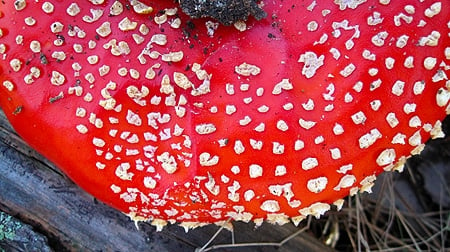
But like I said, I am not into that sort of thing. So I looked deeper. It seems that the primary toxins, er, “active ingredients,” in Amanita muscaria are ibotenic acid and muscimol. Unlike the amatoxins in the deadly amanitas — the death cap and the destroying angel — ibotenic acid and muscimol are water soluble.
More research turned up William Rubel, who knows his stuff when it comes to mushrooms. Rubel wrote an article about how to detoxify fly agaric that proved enlightening.
What’s more, he and David Arora, who is even more reknowned in the mycological world, teamed up on a longer piece (which is linked to at the bottom of Rubel’s article) about cultural attitudes toward Amanita muscaria that provides all the detail you could need on why this mushroom has such a varied place in our minds: Food. Poison. Hallucinogen.
As food, fly agaric does need special handling. Apparently most people eat only the caps or the very young buttons. They must be boiled in a large volume of water for a period of time, and then you need to toss out that water. After that, most cultures will either fry them like normal mushrooms, or pickle them, or preserve them in oil; I happen to know that a certain set of Italians do this. The Japanese around Nagano eat Amanita muscaria as pickles, as do the Lithuanians, Finns and Russians.
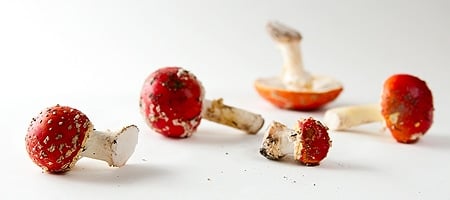
My friend Langdon Cook wrote about eating fly agaric with none other than David Arora, and he pronounced them delicious. Lang also pointed me to a cautionary article written by two mycologists who, apparently, failed to detoxify their muscaria enough. The moral of that article is to use lots of water and boil the hell out of the shrooms.
Back to my grocery bag. By the time I’d screwed up enough courage to mess around with these things, about half had gone by. Bummer. But I still had about 10 good caps to experiment with. What follows is what I did to detoxify the mushrooms. If you choose to play around with Amanita muscaria, do so at your own risk.
- I first removed all the caps and cleaned them with a brush and the side of a knife. Then I cut the caps into 1/4 inch slices.
- I filled my 12-quart stockpot up to the top, leaving about 3 inches of room to spare. I added enough salt to make the water taste salty and 1 cup of cider vinegar. Several sources say that adding salt and vinegar helps extract the toxins.
- I brought this to a boil and added the mushroom caps, then let it roll for 15 minutes.
- I then drained the mushrooms and filled the stockpot half full with fresh water and brought that to a boil. In went the mushrooms for another 5 minutes. Why? If they had gotten too vinegary or salty, this would help. Also, better safe than sorry.
The key to boiling seems to be time and water volume. You need enough water to leach out all the toxins of the mushroom, so it follows that the more muscaria you boil, the more water you’ll need. As for time, it seems 15 minutes is a pretty good interval, according to my sources.
When the slices were done with this treatment, almost all the color was gone from the previously pretty red caps. Oh well. They were still a vague ivory-yellow, but the mushrooms themselves were pale and slippery. Not appetizing. Lang and Arora ate them fried in butter, so I did the same.
I experimented with about 1 cap’s worth of slices. It is always wise to start small with any new mushroom, and especially one that has potentially toxic effects. I put the slices into a non-stick pan and let them dry saute for a few minutes. They did not exude too much water, oddly, so I added some butter and a little salt. I was happy to see the slices fry up crispy. Now we’re talking!
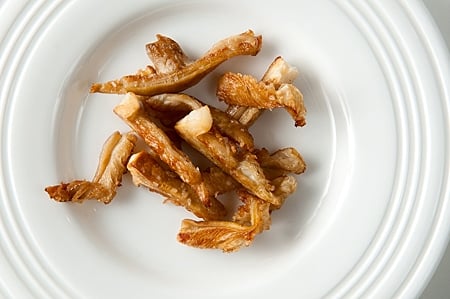
I put them on a little plate, and tentatively took a bite. I’d be lying if I told you I was not at least a little nervous. I tasted butter and salt at first, always nice, but then I got a little crisp, then the squinchy crunchiness of the mushroom, then that nutty flavor everyone who’s eaten muscaria talks about. Reflexively, I reached for another slice, then another and another.
I had to force myself to stop at 1 cap’s worth. They were that good. Now it was time to wait.
The mycologists who’d boiled their muscaria in too little water for too short a time started tripping at 20 minutes. So I sat down to watch Boise State beat the crap out of Arizona State and waited. I was wondering if Boise’s crazy blue uniforms would spark some weird hallucination. But no. I looked at my watch: 45 minutes and nothing. The game got boring. Holly and I then watched a show about a bunch of Vikings getting beheaded in England 1000 years ago, which, in retrospect, was probably not ideal if I were about to go on a mushroom trip. But no. I looked at my watch again: Two hours had passed and nothing.
If a trip were coming, it would have hit by then. What’s more, I had neither stomach cramps nor any other ill effects whatsoever. Success!
Now you may be asking yourself why I would bother messing around with Amanita muscaria when I had just hauled in pounds of boletes? First off, fly agaric is one of the easiest mushrooms in the world to identify. Even though it has some color variation, like the yellow-orange one below, if you stick to the red and orange color phases Amanita muscaria is unmistakable.
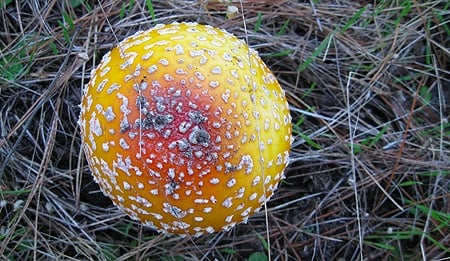
Now white and light-yellow phase muscaria do exist, but I do not recommend messing with those. White amanitas are almost always deadly — the destroying angel chief among them — and mistaking a destroying angel for a white muscaria will be the last mistake you ever make.
And with the yellow ones, you can mistake muscaria for the more-toxic Panther Amanita, Amanita pantherina, which does not have a history of culinary use.
A second reason to consider eating fly agaric is because it is a large mushroom that, as I saw on the Central Coast, can flush in huge numbers. I could easily have collected four grocery bags of them on my last trip, which would have made for lots of good eating down the line.
And good eating is the real reason I will choose to eat Amanita muscaria once or twice a season. It was a delicious mushroom fried in butter, and I suspect it will make an even better preserved mushroom, if the Italians or Russians’ experience is any indication. At the very least, it will be a conversation starter, eh?





Just found a couple in Seattle, dried themm ate one, and about to eat the other. Wish me luck. I’ve done it before.
Have been eating them for years after boiling them for 30 minutes and pouring the water off. If you saute them after the first draining you will feel a euphoria that is quite pleasant for 45 minutes. If you rinse them again after boiling there will be no intoxication. George
Great post! I’m inspired to try your muscaria instructions as soon as the rocky mts begin popping out A. Muscaria. Also, shamans used this mushroom to reach alternate states of mind and to “get in touch” with the spiritual world. So be careful!
you are a brave brave soul! while i would never give this a whirl i love your spirit more now then even before! thanks for this spectacular read! k
As a student at a small college on the coast of Maine I had friends who with their ethnobotanical (or ethnomycological) leanings became part of that A. muscaria. tripping subculture. One of whom, I won’t mention names, went so far as to drink his own urine after consuming the mushroom in the manner of the Siberians who believed the urine contained a more purified form of the hallucinogenic compounds. Greg Marley was a mycological advisor for my friends back then, though I’m positive he wouldn’t advise a couple college kids to trip on Fly agaric. They did that on their own accord. I will share this article with them as they have moved well beyond the days of searching out A. muscaria and prefer these days to hunt for edibles and medicinals like chagga, chantarelles, porcini etc. I’m sure they’d appreciate another encounter with the this iconic mushroom on less intoxicating terms!
Just an awesome post. “Take notes!”
Tamar: I hope so, too! We need to do some fishing or foraging or maybe even hunting in 2012….
Jonny: I am pretty sure that you need to detoxify first, then dry amanita muscaria. I remember reading that drying the mushroom changes the weaker of the two toxins in the ‘shroom into the stronger one, making it harder to detox later. BUT, I’ve never done it, so you’re on your on with this one.
Love this post, Hank. There are so many generic holiday posts out there at the moment, so I was delighted to read this somewhat alternative take on Yuletide foods. Now, I’m assuming that if one just so happened to have some dry fly agaric lying around somewhere for whatever reason – not that I do, of course, being a respectable citizen – one could follow the same process for detoxifying them, which would also serve to rehydrate them, right? Just curious, you know.
Hank, this is awesome. Love the image of you sitting around watching the game waiting to trip, ha ha. I’m jealous of your porcini foraging this time of year. Awesome! Hope you guys have a wonderful holiday.
A better title might be: SHROOMING WITH SANTA C!!!
On second thought, nevermind
Fascinating. I’m just annoyed that I’m gonna have to wait until July/Aug to try them myself. Just imagine, if someone has gotten to a prime bolete spot before you, you could still come away with these critters.
I picked an amanita muscaria many years back, under some trees on the UW campus in Seattle. There were easily 8-10 large capped mushrooms just chilling in the snow – quite a pretty site. I considered eating it for a while. Left it sitting on a shelf as it slowly dried. In the end, I chickened out and tossed it. Next time I run across one, I’ll remember these directions and be braver.
I’ve never tried anamita muscaria mushrooms, but I was reminded of an article I read about them a while ago, “A Study of Cultural Bias in Field Guide Determinations
of Mushroom Edibility Using the Iconic Mushroom, Amanita
muscaria, as an Example”. It’s very interesting and worth a read:
https://www.davidarora.com/uploads/muscaria_revised.pdf
I became interested in the topic after I found out that one of the wild mushrooms that I grew up on, gyromitra esculenta, is toxic. When I was younger my grandfather and I would go out picking morels and the g. esculenta, which he called “beefsteak”. I can only assume that my the methods he used to prepare them removed the toxins, but he was unaware of the toxicity. These days I won’t go near them, although wikipedia claims they’re a delicacy in scandinavia.
You are a brave boy, Hank! I see them all the time, and have wondered about them, but not taken the plunge myself. New goodies for the larder! I will be delighted to try them sometime soon, thanks for the footwork!
Also, Holly’s right, the link is quite amusing.
Wow! What a great post – even here in the north of Germany where mushrooming has a long tradition, the ‘notorious’ Fliegenpilz (Fly mushroom) is renowned for being deadly poisonous! It’s a bit too late for us this year, but I’m looking forward to trying it. Thanks for all the research, keep up the great work!
All the best for 2011
Agreed- you guys are brave :). And I’ll totally try this if I ever come across them (your version not the tripping version)…
And folks, do click on that cautionary article Hank linked to. It’s pretty damn funny, in a mild-mannered Hunter S. Thompson sort of way…
Thank you for this great post. So appropriate for Christmas. Hope you are having a Merry Christmas!
Hank, VERY brave.
Always enjoy reading your posts. I do skipped the animal-hunting part sometime.
Wishing you a very best 2012 !!
Cindy
Hank, it seems suitable that I’m reading this on Christmas day, and it’s one of my favorites of so many fine posts. It is with some shame that I admit that one of the reasons I read you obsessively is that you do leg work that I, then, don’t have to do. We have fly agaric here on Cape Cod, and now I will eagerly await the next big flush so I can follow your instructions and try it for myself.
As the year is closing in, let me also thank you for the recipes, instructions, ideas, and inspiration I find here on a regular basis, and one outstanding book.
Best of the new year from Kevin and me to you and Holly. I’m hoping we’ll all be in the same place at the same time at some point. Bonus if there are fish there, too. Or mushrooms. Or maybe deer. Yeah, deer.
Tamar